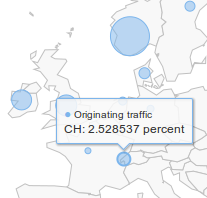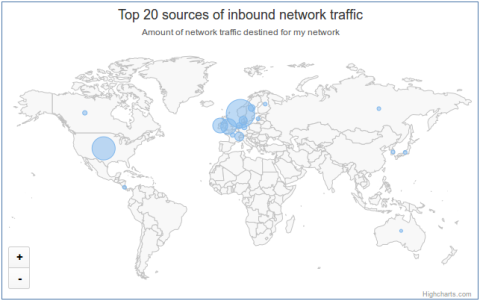Geomapping network traffic
Did you ever wonder where your network traffic goes (and originates from)? With the SiLK suite and optionally some JavaScript map classes it’s quite easy to find out.
SiLK is a tool quite equal to Cisco‘s NetFlow, and SiLK does indeed accept NetFlow output from a router. Just like NetFlow tools, SiLK stores network traffic metadata (like “when” and “where”, but not “what”), so as opposed to capturing the complete network traffic SiLK can store a lot of information over a long time without eating too much disk space. In my setup I’ve configured my Mikrotik router to transmit traffic flow data to a Linux server running SiLK.
With GeoIP mapping, SiLK can identify the country of source and destination IP addresses. Combined with a “top 20” construct, it turned out easier than expected to create a world map like this:
For the map I’ve been using the very useful JavaScript interactive Highchart maps (Highmaps) from the Norwegian company Highsoft. To feed the map with data I wrote a small piece of code that converts the output from SiLK’s rwfilter/rwstats output to JSON, which makes the map dynamically update itself upon refresh.
 As shown on the screenshot to the left, when hovering the mouse over each bubble the JavaScript map code will show the percentage value of the traffic associated with the different countries. When identifying traffic from unexpected sources you can use the command line based SiLK tools to drill down in order to find out what’s really going on, like in this case when I was wondering what was being transferred from Switzerland (it turned out to be some Flash movies the kids were watching). In addition to the command line tools there are also GUI and web based interfaces for querying SiLK data. The command used to find the source IP and port for the traffic originating from Switzerland (.ch) is shown below:
As shown on the screenshot to the left, when hovering the mouse over each bubble the JavaScript map code will show the percentage value of the traffic associated with the different countries. When identifying traffic from unexpected sources you can use the command line based SiLK tools to drill down in order to find out what’s really going on, like in this case when I was wondering what was being transferred from Switzerland (it turned out to be some Flash movies the kids were watching). In addition to the command line tools there are also GUI and web based interfaces for querying SiLK data. The command used to find the source IP and port for the traffic originating from Switzerland (.ch) is shown below:
# rwfilter --start-date=2015/10/09 --end-date=2015/10/09 \
--proto=0-255 --type=all --pass=stdout --scc='ch' | rwstats --top \
--count=5 --fields=sip,sport --value=bytes
INPUT: 327 Records for 19 Bins and 39783096 Total Bytes
OUTPUT: Top 5 Bins by Bytes
sIP|sPort| Bytes| %Bytes| cumul_%|
80.239.148.37| 1935| 38839614| 97.628435| 97.628435|
62.48.3.112| 80| 476083| 1.196697| 98.825132|
80.239.148.47| 1935| 402414| 1.011520| 99.836652|
80.239.148.44| 80| 15276| 0.038398| 99.875050|
80.239.148.45| 443| 9328| 0.023447| 99.898497|
There’s a few snags with my setup, but with some tweaking it gives a general idea and I think I’ve handled the corner cases. These are the knows issues – so far:
- This setup is a NATed IPv4 network environment. In order to detect inbound traffic I have to enter my router’s outside address as the destination. This address might change now and again, breaking historical data.
- I’m also running an IPv6 network provided by HE.net (tunnelbroker.net). My allocated IPv6 ranges are consequently registered as physically located in the US, so SiLK will register any internal-only IPv6 network traffic as based in the US, increasing that percentage.
